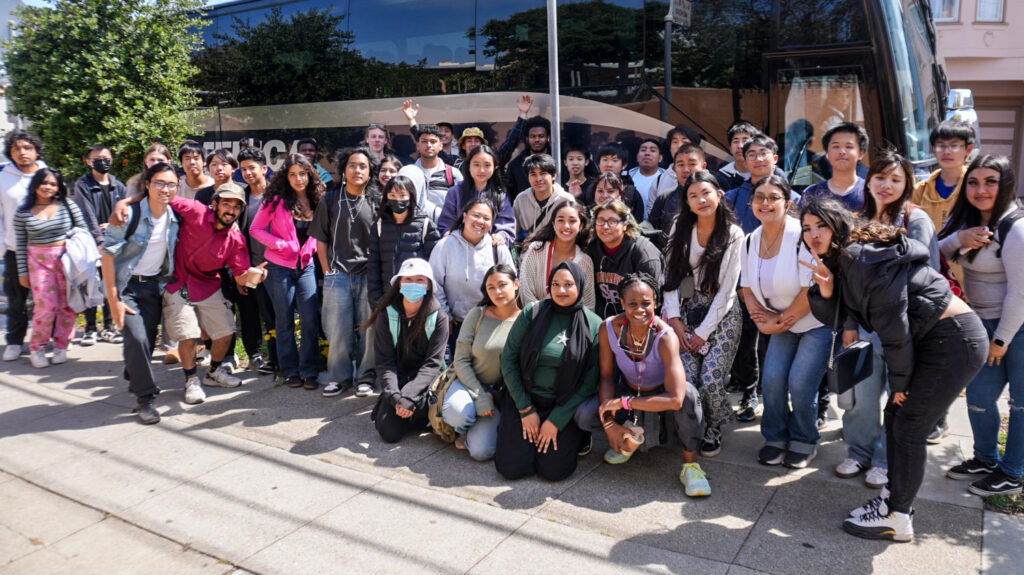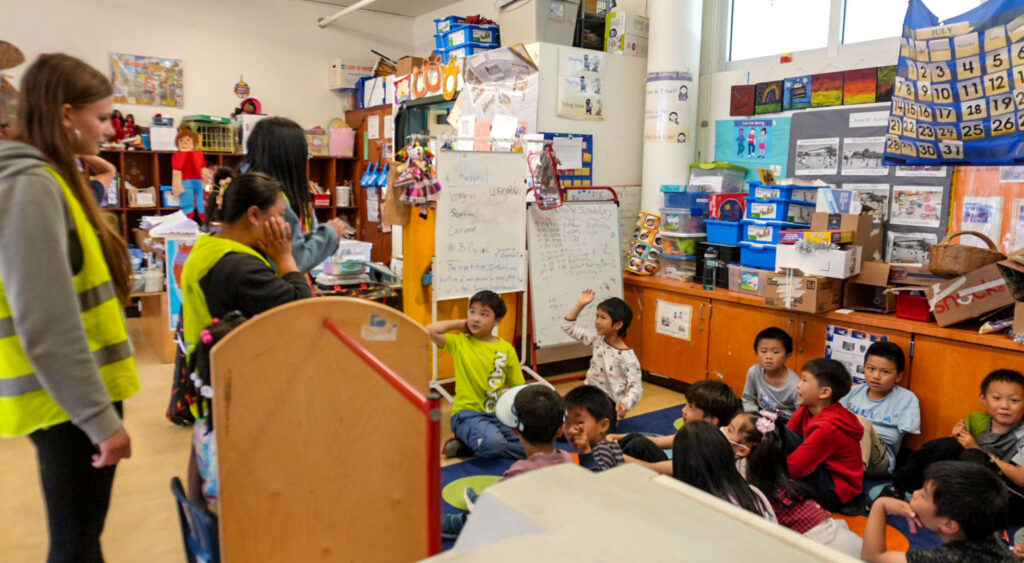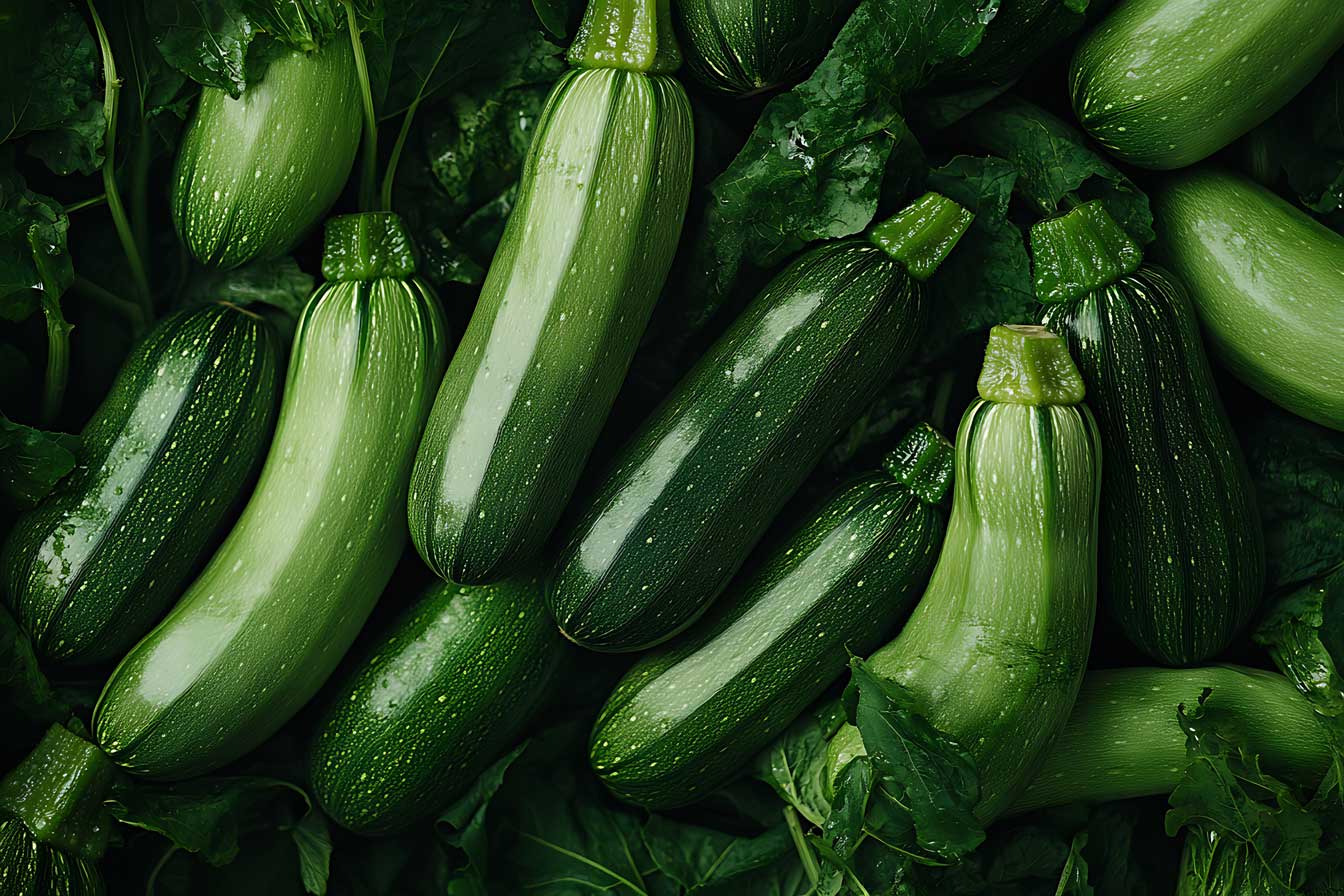The Green Gazette
Intern News – SF Summer 2024
In This Issue
This Week’s Activities
- This Week’s Lesson:
Food Injustice - Working with the Kids
- Erika Foster’s Visit + Soil Testing
- Field Trip to Filoli Gardens
Interview
Crop of the Week
Word Search Puzzle

This Week’s Activities
This Week’s Lesson
Food Injustice
The theme of this week was food injustice. Our food systems operate on local, national, and international scales. In many places, factors such as income, ethnicity, and disabilities play a vital role in whether or not a person is food-secured. Food insecurity is when an individual or household does not have access to adequate, healthy, and affordable food. This condition manifests in various ways, such as traveling far distances to a supermarket or going without meals for days. This affects a person’s quality of life and mental and physical well-being.
One of the first documented movements against this issue was in 1962 in Mississippi. This was during the time when people of color were fighting for desegregation and civil rights. To keep them oppressed and submissive, white politicians cut 90% of food funding for black people. This led to the Black Panthers’ complimentary breakfast program, a notable community service initiative launched in January 1969 in Oakland, California, to address the issue of food insecurity and ensure that children in underserved communities started their day with nutritious meals. This instrumental program catalyzed our current Congress to increase their funding for school lunches.
Learning how to grow your food creates food sovereignty which is vital. We should be able to define our food and agriculture systems, making them just, equitable, and sustainable. Additionally, farmers, indigenous peoples, and local communities should not be denied access to land, seeds, and water. Their traditional knowledge and practices should be protected.
JD’s lecture concluded with an empowering quote by Dr. Martin Luther King, Jr:
In the United States of America, we spend almost ten billion dollars a year to store the surplus food that we have in the nation. And I say to myself as I look at these conditions, ‘I know where we can store that food free of charge, in the wrinkled stomachs of hungry men and women and children of God all over the world.’
This critique underscores the irony of surplus resources amid widespread poverty and food insecurity, advocating for economic and social justice through equitable resource distribution. King advocated for economic and social justice, suggesting we evenly distribute our resources to meet everyone’s needs.
End of Summer BBQ:
Celebrating Our Knowledge

At the end of the summer session, we put together a barbeque to celebrate our program and discuss the importance of healthy food. As a result of these types of discussions all summer long, we interns are trained in agricultural knowledge and practices. Now, we enjoy the fruits of our collective efforts. When our trees give us lemon, we make lemonade!
We also picked plums which prospered this year. Additionally, we created food like veggie skewers, beef, chicken, and guacamole. For dessert, we experimented with making ice cream from heavy cream and ice, then roasted marshmallows for s’mores.

san miguel early education school
Working with the Kids
We were elated to begin our journey working with the kids at San Miguel Early Education School. In rooms 23 and 24, we kicked off our time together with a fun and engaging icebreaker activity called ‘Make a Salad.’ During this activity, the kids enthusiastically shared their favorite fruits and vegetables, and we had a great discussion about how all the produce they mentioned could be grown right here in their schoolyard!
We also participated in some classic games, which helped us to bond and get to know one another. We played ‘Heads Up, Seven Up,’ where kids enjoyed trying to guess who tapped their thumbs, and ‘Telephone,’ which brought lots of laughter. You start with the original message and it’s passed from student to student through whispers. Wherever you start, you always end up repeating a different or funny phrase.
These activities not only broke the ice but also laid the foundation for a beautiful learning experience. As a result, we look forward to many more fun and educational moments with the kids there.
Guest workshop
Erika Foster’s Visit + Soil Testing
This week, we were pleased to host Erika Foster, the Director of Soil Research and Conservation at Point Blue, which focuses on soil testing on range and farmland up and down California, emphasizing carbon levels. The organization was formerly known as the Point Reyes Bird Observatory, founded in 1965 by a group of ornithologists and bird enthusiasts. Their organization has been at the forefront of addressing climate change impacts on wildlife and conducting research to implement climate adaptation and resilience strategies. The science-based conservation efforts commitments have produced valuable advancements in understanding and addressing environmental issues.
Erika earned her B.S. in Natural Resource Conservation and a minor in Wilderness Studies (U of Montana, Missoula) and then a PhD in Ecology in Soil and Crop Sciences (Colorado State University, Fort Collins). She taught us the basics of soil sampling, while highlighting the often-overlooked world of underground organisms. California is diverse in many ways, and soil is no exception. From soil fauna and microbes, there are more organisms in a handful of soil than the human population! Soil is the foundation of agriculture; therefore, increasing biodiversity below ground will benefit the whole agricultural system.
Soil Horizons on Our Bioswale
Last week, JD discussed the four elements, including Earth, and now we had the opportunity to experiment with a few materials they use in the actual field, such as a drill, to test for soil density and infiltration in our garden. We discovered significant soil behavior variations within a few feet and tested the soil quality atop the bioswale. We used the auger to dig around a few feet deep and learned about the horizon of the soil. It’s a distinct soil layer with unique characteristics and properties differing from the layers above and below it. It is designated by letters which characterize the soil profile.
The layers we got a chance to view were the “O” and “A” horizons. The ‘O’ horizon consists of organic material such as decomposed leaves and animal manure. This layer is crucial for plant growth due to its nutrient-rich quality. The “A” horizon, also known as the topsoil, contains a mixture of organic matter with minerals and is where root activities occur.
Filoli Garden Field Trip
Moreover, in the past week, we embarked on an exciting field trip to Filoli Garden! Once the clock hit 9:30, the interns boarded the bus. It was lovely to have our executive director, China Bushell, accompany us. The historic country estate in Woodside, California, is renowned for its garden and mansion dedicated to preservation and horticulture. The name derives from William Bowers Bourn II’s motto: “Fight for a just cause. Love your Fellow Man. Live a Good Life,” taking the first two letters of the keywords— fight, love, and live. Bourn, a prominent San Francisco businessman and owner of the Empire Mine, one of California’s richest gold mines, constructed the estate.
From 1937 to 1975, after Bourn’s passing, the mansion was owned by William P. Roth and his wife, Lurline Matson Roth, who expanded the estate’s horticulture collection. In 1975, Lurline Roth donated Filoli to the National Trust for Historic Preservation, transitioning it into a public estate that attracts visitors and is cherished by many annually.
We toured the mansion, marveling at its splendid architecture, and we visited a room used for the Woodside Summit, the diplomatic meeting between President Joe Biden and President Xi Jinping of China. Surrounded by the picturesque Santa Cruz Mountains, we engaged in an art project, choosing scenic spots to draw using construction paper, watercolor pencils, and water brushes.
We then explored the Carolyn Fulgham Butcher vegetable garden, which opened in 2022. The garden holds a diverse array of vegetable and fruit crops, including various types of cucumbers, lemons, and beets. It also features an excellent example of the ‘Three Sisters’ planting method. They grew tall stalks of corn where the pea vines grow upward — both plants keep the squash beetles away and allow light shade for the squash. They have a symbiotic relationship and provide what the other plant needs to succeed. Especially for squash, the different plants fix a copious amount of nitrogen, which allows the crops to grow large. In addition, we learnt that they grow fragrant plants such as lavender in front of each row to keep mice away; marigolds are also grown in front to attract pollinators.
We harvested and sampled the garden’s vegetables which tasted far superior to store-bought produce. JD’s lectures explained that this is due to the absence of GMOs and insecticides. We, indeed, are what you eat, and it’s essential to consume healthy foods to keep your body healthy and nourished. People who receive food aid are only able to buy food that is of lower quality and that l leads to health concerns. And where are these inferior supermarkets found? In food deserts. Such locations are exacerbated in this inequality, where heavily engineered and chemically laden foods dominate. The biggest issue is that this information is suppressed and normalized which is why and how we conform.
Our non-profit aims to empower people by teaching them how to grow their own food, ensuring they know its source, and promoting self-determination and self-actualization. We also collaborate with schools to help children acquire agricultural skills so that they, too, enjoy fresh produce grown on their school grounds.
Interview
In the next couple of issues, we want to highlight the women behind A Living Library! First, we would like to introduce China Bushell, our executive director.
Meet Our Executive Director

From a young age, China was enriched by a wide variety of foods. Her parents were prominent chefs as well as from diverse cultural backgrounds and ethnicities (her mom is Chinese and half Trinidadian; her dad’s mother is from Spain, and his father is from Puerto Rico). For many years, she owned and ran a restaurant.
After selling her restaurant, she taught students at a school that ran a youth farmer’s market about gardening and food sustainability through cooking. Her teaching promoted healthy food, changing young minds from choosing potato chips to apples, and provided teenagers with knife skills that can be transferred to the real world. Additionally, she received a bachelor’s degree from Columbia University, where she was inspired to be a humanitarian and led her path to becoming an entrepreneur. As stated in the interview, “In my life, I’ve had several work stages — all that has led me to this moment, which is to continue Bonnie’s work and to enrich young people’s lives.”
After working with the organization for several years, the reason that kept her going is the reward of working with fresh young minds and building leaders in the next generation who will use their talents to paint the world GREEN. She put in effort behind the scenes to raise funds to sustain the program. She mentioned that funding is one of the biggest challenges: “Most of our grants fund a purpose and not a person, and most of us work for far less than we would receive elsewhere.” Due to our immense passion, all of us tirelessly dedicate our work to positively influence young minds and provide opportunities, for those who believe in a group of like-minded adults, who were once those shy, underrepresented young people, who might not have a B.A. or just want to create possibilities.” China believes in curating a team of people with diverse backgrounds to harness all their potential. She notes that people of color have historically been pitted against each other, but instead, they should unite for a common cause. Through her dedication and vision, China continues to pave the way for a greener, more inclusive future.
Crop of the Week


Zucchini
Time of Year: Zucchini should be planted after the frost has passed, typically in late May to early July when the soil is at least 65 to 70 degrees. Additionally, they grow better in mounds or hills 3-6 inches apart.
Harvest: For flavorful fruits, it’s advised to harvest them when they reach 6-8 inches long, generally 60 days after planting or one week after they flower. Cut the zucchini off the vine with a sharp knife, leaving at least 1 inch of stem on the fruit.
Watering: They thrive in moist soil— water at least 1 inch weekly. As its fruit forms, water diligently with at least 4 inches down. Adding mulch is also recommended in order to help retain moisture.
Companion Plants:
- Beans. Beans fix nitrogen levels in soil in order to grow larger fruits
- Garlic and Marigold: help repel pests such as aphids
- Nasturtiums: Plant Nasturtiums – are pretty flowers that attract aphids – to attract pests away from the vegetables you planted